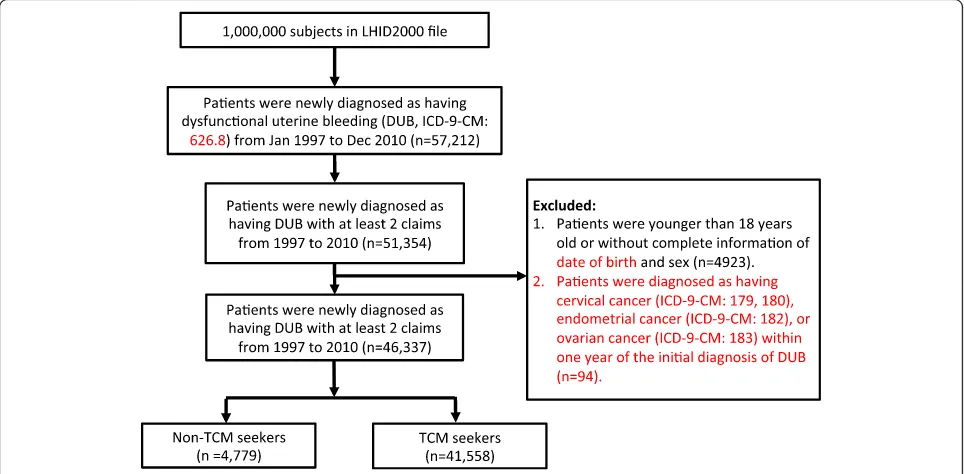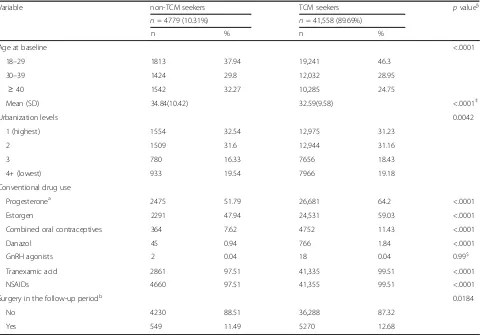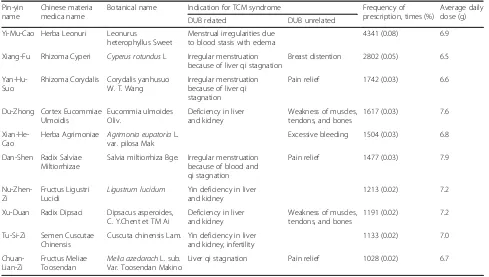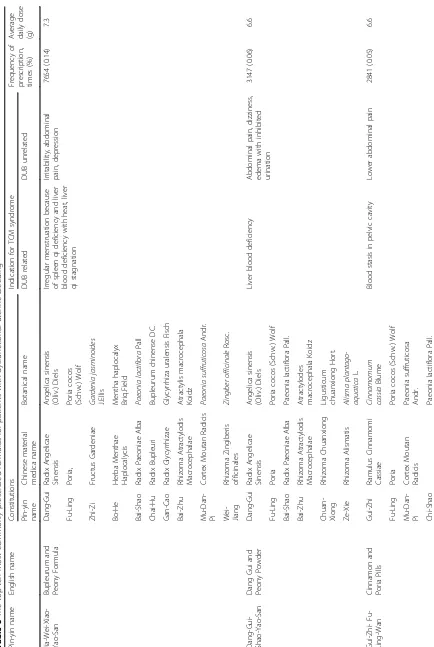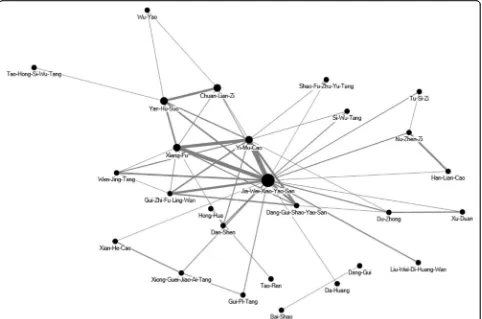R E S E A R C H A R T I C L E
Open Access
The utilization of traditional Chinese
medicine in patients with dysfunctional
uterine bleeding in Taiwan: a nationwide
population-based study
Yi-Rong Lin
1, Mei-Yao Wu
2, Jen-Huai Chiang
3,4, Hung-Rong Yen
1,2,5,6,7*and Su-Tso Yang
1,8*Abstract
Background:Many patients with gynecological disorders seek traditional medicine consultations in Asian countries. This study intended to investigate the utilization of traditional Chinese medicine (TCM) in patients with
dysfunctional uterine bleeding (DUB) in Taiwan.
Methods:We analyzed a cohort of one million individuals randomly selected from the National Health Insurance Research Database in Taiwan. We included 46,337 subjects with newly diagnosed DUB (ICD-9-CM codes 626.8) from January 1, 1997 to December 31, 2010. The patients were categorized into TCM seekers and non-TCM seekers according to their use of TCM.
Results:Among the subjects, 41,558 (89.69%) were TCM seekers and 4,779 (10.31%) were non-TCM seekers. Patients who were younger tended to be TCM seekers. Most of the patients had also taken Western medicine, especially tranexamic acid and non-steroidal anti-inflammatory drugs (NSAIDs). More than half of TCM seekers (55.41%) received combined treatment with both Chinese herbal remedies and acupuncture. The most commonly used TCM formula and single herb were Jia-Wei-Xiao-Yao-San (Bupleurum and Peony Formula) and Yi-Mu-Cao (Herba Leonuri),
respectively. The core pattern of Chinese herbal medicine for DUB patients consisted of Jia-Wei-Xiao-Yao-San, Xiang-Fu (Rhizoma Cyperi), and Yi-Mu-Cao (Herba Leonuri).
Conclusions:TCM use is popular among patients with DUB in Taiwan. Further pharmacological investigations and clinical trials are required to validate the efficacy and safety of these items.
Keywords:Complementary and alternative medicine, Chinese herbal medicine, Dysfunctional uterine bleeding, National Health Insurance Research Database, Traditional Chinese medicine
Background
Dysfunctional uterine bleeding (DUB) is defined as exces-sive, prolonged, frequent, and unpattern bleeding from the uterine in the absence of any structural etiology [1]. In order to standardize the terminology, diagnosis and inves-tigations of abnormal uterine bleeding, the FIGO classifi-cation system (PALM-COEIN) was published in 2011 [2].
DUB is considered as non-structural abnormal uterine bleeding.
DUB significantly and negatively impacts the patient’s physical and social quality of life. It may put patients at risk for developing anemia, fatigue, and depression. Patients with heavy menstrual bleeding had higher hospitalization rates, emergency room visits, and outpatient visits [3]. Otherwise, heavy bleeding had significant economic implications for women because it was associated with work loss [4].
Current treatments for DUB include combined oral con-traceptives, progestogens, non-steroidal anti-inflammatory drugs (NSAIDs), tranexamic acid, gonadotropin-releasing hormone analogues, danazol, and levonorgestrel-releasing * Correspondence:hungrongyen@gmail.com;yangst@mail.cmu.edu.tw
1Graduate Institute of Chinese Medicine, School of Chinese Medicine,
College of Chinese Medicine, China Medical University, 91 Hsueh-Shih Rd. North District, Taichung 404, Taiwan
Full list of author information is available at the end of the article
intra-uterine system (LNG IUS) [5]. Endometrial ablation and hysterectomy are the surgical options for DUB. Surgi-cal treatments are recommended in the presence of mediSurgi-cal therapy failure, severe anemia, or other concomitant uter-ine pathology [6]. However, tranexamic acid not only in-creases the risk of thrombosis but also has side effects such as headache, anemia, and fatigue [7]. In addition to the risks of blood loss and ureteric injury, hysterectomy is not suit-able for the women with fertility plan. Current conventional treatments do not fit the need of all DUB patients. There-fore, TCM therapy can provide an alternative option for these patients. TCM therapy has advantages in treating the patients with gynaecological disorders, including DUB, pre-menstrual syndrome, menopausal syndrome, and uterine fi-broids [8, 9]. DUB is known as“flooding and spotting (Ben Lou)”in TCM literature. In TCM theory, normal menstrual cycle and fertility are regulated by the thoroughfare and controlling vessels (Chong Ren) and the essential qi of kid-ney. Strengthening the thoroughfare vessels, supplementing the kidney yin and yang, dissipating blood stasis, and cool-ing the blood to secure controllcool-ing vessels are the main principles in TCM treatments of DUB. However, a large-scale survey on the complementary TCM utilization among patients of DUB is lacking.
Therefore, this study intends to investigate TCM usage and prescription patterns for patients with DUB. We aimed to investigate the core prescription of TCM for patients with DUB and provide valuable information for TCM doctors and gynecologists. The results of this
study will be useful for further research in clinical trials and pharmacological investigations in the future.
Methods Data sources
The National Health Insurance (NHI) program was launched in Taiwan in 1995. It has covered more than 99% of Taiwan-ese residents in 2015 [10]. TCM services, including ChinTaiwan-ese herbal medicines, acupuncture/moxibustion, and Chinese traumatology therapy, have been covered by the NHI pro-gram since 1996. The NHI administration constructed a Na-tional Health Insurance Research Database (NHIRD), which was managed by the National Health Research Institutes in Taiwan. All of the datasets were de-identified and encrypted before release for scientific research. This database contains original data including demographic characteristics, medical care facilities, outpatient and inpatient visits, visit dates, diagnostic codes, management, prescriptions and medical expenditures. The diagnostic codes were in the format of the International Classification of Diseases, Ninth Revision, Clinical Modification (ICD-9-CM).
Study population
A randomly selected sample with one million individuals who were enrolled in the NHI program was analyzed. Pa-tients with newly diagnosed DUB (ICD-9-CM codes 626.8) from January 1, 1997 to December 31, 2010 were identified from the database (Fig. 1). To avoid the inclusion of pa-tients who did not truly have DUB, we only included the
Fig. 1Flow recruitment chart of patients with dysfunctional uterine bleeding (DUB). We identified the newly diagnosed DUB patients from 1997 to
[image:2.595.57.539.448.685.2]patients with at least 2 claims of DUB. We excluded the pa-tients who were less than 18 years of age, or were missing information on their sex (male and female) and date of birth. Moreover, we excluded patients who were diagnosed as having cervical cancer, endometrial cancer, or ovary can-cer within one year of the initial diagnosis of DUB. TCM seekers were defined as those who visited the TCM doctors after they were diagnosed as having DUB. Non-TCM seekers were defined as patients who never visited TCM clinics after the initial diagnosis of DUB. Ultimately, 46,337 subjects were included and were divided into groups of TCM seekers (n = 41,558) and non-TCM seekers (n= 4779). This study was approved by the Research Ethics Committee of China Medical University and Hospital (CMUH104-REC2–115).
Traditional Chinese medicine treatments
Chinese herbal formulas were listed in pin-yin name and English name. Single herbs were listed in pin-yin name, Chinese materia medica name and plant name. The TCM indications of the Chinese herbal formulas and single herbs were based on TCM theory [11, 12]. Full botanical names comply with the International Plant Names List (IPNI; http://www.ipni.org) and The Plant List (http:// www.theplantlist.org/) [13]. We used a network analysis open-sourced freeware NodeXL (http://nodexl.codeplex.-com/) to determine the core pattern of Chinese herbal medicine prescribed for DUB patients. As described in our previous reports [14], the thicker the line was, the more interrelated were the Chinese herbal formulas and the co-prescribed Chinese herbal formulas.
We analyzed the acupuncture and Chinese traumatol-ogy that patients received by the treatment codes in the datasets. Acupuncture includes traditional Chinese man-ual acupuncture, electroacupuncture, and moxibustion. Chinese traumatology indicates traditional Chinese medi-cine traumatology and orthopedics, which is a combin-ation of massage, acupressure, and body manipulcombin-ation.
Statistical analysis
All statistical analyses were performed using SAS software, version 9.4 (SAS Institute Inc., Cary, NC, U.S.A.). A univar-iate analysis was conducted to compare the TCM seekers with the non-TCM seekers. The data analysis included descriptive statistics, including the frequency of TCM pre-scriptions, the patients’demographic characteristics, indi-cations for the prescription of TCM, and the most frequently prescribed herbal formulas and herbs for the treatment of DUB. We used t-test and chi-square test to examine the differences of numerical variables and categor-ical variables between two cohorts, respectively. The frequency of co-morbidities, which were the medical con-ditions as the reasons that DUB patients visited the clinics, between the two cohorts was compared using chi-square
test. AP-value of <0.05 was considered statistically signifi-cant. The urbanized residence levels of all individuals were classified into four grades based on a previous study. Level 1 represents the highest urbanized level and 4 represents the lowest level [15].
Results
Among one million beneficiaries, a total of 46,339 pa-tients with newly diagnosed DUB between 1997 and 2010 were enrolled in this study (Fig. 1). Among these subjects, 89.69% (n = 41,558) visited TCM doctors for clinical consultation or treatment. Patients within the range of 18–29 years old were most likely to receive TCM treatment (Table 1). Patients who lived in highly urbanized areas preferred to use TCM. Large portion of TCM seekers also took Western medications, especially tranexamic acid and NSAIDs.
With regard to the treatment approaches, 55.41% of the TCM seekers received combined treatment of both Chinese herbal remedies and acupuncture/traumatology, and 44.28% of patients only received prescribed Chinese herbal remedies (Table 2). Regarding the frequency of visits, 71.02% of patients visited TCM clinics for 1 to 3 times/year, while 18.48% of patients consulted TCM doctors more than 6 times/year.
We compared the frequency of different diseases, in-cluded DUB-related and unrelated co-morbidities, be-tween non-TCM and TCM seekers (Table 3). TCM seekers had high frequency of anemia, menopausal syn-drome, and female infertility. Moreover, TCM seekers also had higher frequency in psychological symptoms such as depression, insomnia, or sleep disturbance. High incidence of vertigo/dizziness, migraine/headache, di-gestive disorders, and upper respiratory infection in TCM seekers were also demonstrated.
To identify the prescription patterns, we further analyzed the Chinese herbal formulas prescribed by TCM doctors. The most commonly used TCM formula and single herb were Jia-Wei-Xiao-Yao-San (Bupleurum and Peony Formula) and Yi-Mu-Cao (Herba Leonuri), respectively (Table 4 and Table 5). The core patterns of Chinese formu-las and herbs prescribed for DUB patients were examined in the network analysis. The core pattern and the most frequently used combinations of formulas and single herbs consisted of Jia-Wei-Xiao-Yao-San, Xiang-Fu (Rhizoma Cyperi), and Yi-Mu-Cao (Herba Leonuri) (Fig. 2).
Discussions
Jia-Wei-Xiao-Yao-San (Bupleurum and Peony Formula) and Yi-Mu-Cao (Herba Leonuri) were the most commonly used TCM formula and single herb, respectively. This was the first population-based cohort study to investigate the TCM utilization patterns among patients with DUB. The analysis of TCM formulas in DUB treatment could pro-vide useful information for further clinical trials and pharmacological investigations.
[image:4.595.59.539.98.433.2]Our result revealed that patients with young age or lived in highly urbanized areas preferred to receive TCM treat-ment, which was consistent with the previous studies [16, 17]. TCM is popular among female patients. Our previous study found that patients with uterine fibroid had a high utilization rate of TCM [9]. In this study, we found that large portions of TCM seekers also received conventional treatment. It is possible that patients with better Table 1Demographic characteristics of the patients with newly diagnosed dysfunctional uterine bleeding from 1997 to 2010 in Taiwan
Variable non-TCM seekers TCM seekers pvalue§
n= 4779 (10.31%) n= 41,558 (89.69%)
n % n %
Age at baseline <.0001
18–29 1813 37.94 19,241 46.3
30–39 1424 29.8 12,032 28.95
≥40 1542 32.27 10,285 24.75
Mean (SD) 34.84(10.42) 32.59(9.58) <.0001‡
Urbanization levels 0.0042
1 (highest) 1554 32.54 12,975 31.23
2 1509 31.6 12,944 31.16
3 780 16.33 7656 18.43
4+ (lowest) 933 19.54 7966 19.18
Conventional drug use
Progesteronea 2475 51.79 26,681 64.2 <.0001
Estorgen 2291 47.94 24,531 59.03 <.0001
Combined oral contraceptives 364 7.62 4752 11.43 <.0001
Danazol 45 0.94 766 1.84 <.0001
GnRH agonists 2 0.04 18 0.04 0.99$
Tranexamic acid 2861 97.51 41,335 99.51 <.0001
NSAIDs 4660 97.51 41,355 99.51 <.0001
Surgery in the follow-up periodb 0.0184
No 4230 88.51 36,288 87.32
Yes 549 11.49 5270 12.68
‡t test;§
Chi-square;$
Fisher exact test
Abbreviations:TCMtraditional Chinese medicint,NSAIDsnon-steroidal anti-inflammatory drugs
a
Progesterone: progesterone only pills, medroxyprogesterone acetate b
Surgery: endometrial ablation, resection, and hysterectomy
Table 2Distribution of different treatment types of traditional Chinese medicine received by patients with dysfunctional uterine bleeding, stratified by the number of outpatients visits
Number of TCM visits (times/per year)
Only Chinese herbal medicine Only Acupuncture or traumatology Combination of both treatment Total of TCM seekers (N= 41,558)
N= 18,401 (44.28%) N= 130 (0.31%) N= 23,027 (55.41%)
n (%) n (%) n (%) n (%)
1–3 15,460 (84.02) 128 (98.46) 13,925 (60.47) 29,513 (71.02)
4–6 1255 (6.82) 0 3110 (13.51) 4367 (10.51)
>6 1689 (9.16) 2 (1.54) 5992 (26.02) 7678 (18.48)
Abbreviation:TCMtraditional Chinese medicine
[image:4.595.58.537.624.707.2]compliance to Western medications would be more likely to use TCM or that the severity of the disease was higher in TCM seekers. Because of the concern over side effects from the conventional treatment, patients with DUB may tend to seek TCM service for a second opinion. More than half of TCM seekers received both herbal medicine and acupuncture. One of the possible reasons is that the DUB patients had more complicated situations that required a
combinational treatment of herbal remedies and acupunc-ture. The complicated situations of patients with DUB as revealed in Table 3 also indicated that they commonly had psychological disorders, anemia, migraine or other sys-temic disorders.
[image:5.595.57.542.99.280.2]Of the top ten commonly prescribed formulas identified in our study, Jia-Wei-Xiao-Yao-San and Dang-Gui-Shao-Yao-San share common features to nourish blood, regulate Table 3Frequency of different diseases in patients with dysfunctional uterine bleeding
Disease (ICD-9-CM) Non-TCM seekers TCM seekers pvalue*
Frequency % Frequency %
DUB related
Anemia (280.9, 281.8, 285.9) 799 16.72 9583 23.06 <.0001
Menopausal syndrome (627) 746 15.61 9071 21.83 <.0001
Female infertility (628) 311 6.51 5807 13.97 <.0001
Complications of pregnancy, child birth and the puerperium (630–676) 1761 36.85 18,785 45.20 <.0001
DUB unrelated
Vertigo, dizziness, Meniere’s Syndrome (386, 780.4, 780.7) 1813 37.94 25,138 60.49 <.0001
Depression, insomnia, sleep disorders (300, 311, 307.4, 780.5) 1449 30.32 25,976 62.51 <.0001
Migraine and headache (346, 784.0) 1753 36.68 27,494 66.16 <.0001
Upper respiratory tract infection (460–465, 784.1) 4475 93.64 41,111 98.92 <.0001
Digestive disorders (536, 564, 787.7) 2557 53.50 33,740 81.19 <.0001
*Chi-square test
Abbreviation:TCMtraditional Chinese medicine,DUBdysfunctional uterine bleeding
Table 4The top ten most commonly prescribed herbs for patients with dysfunctional uterine bleeding
Pin-yin name
Chinese materia medica name
Botanical name Indication for TCM syndrome Frequency of prescription, times (%)
Average daily dose (g)
DUB related DUB unrelated
Yi-Mu-Cao Herba Leonuri Leonurus
heterophyllus Sweet
Menstrual irregularities due to blood stasis with edema
4341 (0.08) 6.9
Xiang-Fu Rhizoma Cyperi Cyperus rotundusL Irregular menstruation because of liver qi stagnation
Breast distention 2802 (0.05) 6.5
Yan-Hu-Suo
Rhizoma Corydalis Corydalis yanhusuo W. T. Wang
Irregular menstruation because of liver qi stagnation
Pain relief 1742 (0.03) 6.6
Du-Zhong Cortex Eucommiae Ulmoidis
Eucommia ulmoides Oliv.
Deficiency in liver and kidney
Weakness of muscles, tendons, and bones
1617 (0.03) 7.6
Xian-He-Cao
Herba Agrimoniae Agrimonia eupatoriaL. var. pilosa Mak
Excessive bleeding 1504 (0.03) 6.8
Dan-Shen Radix Salviae Miltiorrhizae
Salvia miltiorrhiza Bge. Irregular menstruation because of blood and qi stagnation
Pain relief 1477 (0.03) 7.9
Nu-Zhen-Zi
Fructus Ligustri Lucidi
Ligustrum lucidum Yin deficiency in liver and kidney
1213 (0.02) 7.2
Xu-Duan Radix Dipsaci Dipsacus asperoides, C. Y.Chent et TM Ai
Deficiency in liver and kidney
Weakness of muscles, tendons, and bones
1191 (0.02) 7.2
Tu-Si-Zi Semen Cuscutae Chinensis
Cuscuta chinensis Lam. Yin deficiency in liver and kidney, infertility
1133 (0.02) 7.0
Chuan-Lian-Zi
Fructus Meliae Toosendan
Melia azedarachL. sub. Var. Toosendan Makino
Liver qi stagnation Pain relief 1028 (0.02) 6.7
Abbreviation:TCMtraditional Chinese medicine,DUBdysfunctional uterine bleeding
[image:5.595.55.544.439.716.2]menstrual cycle, and relieve emotional and psychological symptoms clinically. Previous studies found that Jia-Wei-Xiao-Yao-San ameliorated depression in menopausal women through increasing serum TNF-α [18, 19] and Dang-Gui-Shao-Yao-San improved depression-like behav-iors in murine model through decreasing central arginine vasopressin [20]. Highly utilization rate of these two formu-las may be due to the high incidence of psychological disor-ders in patients with DUB. Moreover, Dang-Gui-Xiao-Yao-San also exerted analgesic effect on dysmenorrhea through suppression of uterine smooth muscle contractions [21] and corrected luteal phase insufficiency [22]. Gui-Zhi-Fu-Ling-Wan, the formula commonly used to treat menstrual disorders caused by blood stasis, has been demonstrated to exert estrogen-like activity to relieve the symptoms of cli-macteric disorders [23] and decrease uterine contraction to attenuate dysmenorrhea [24].
Of the ten commonly used single herbs identified in this study, Yan-Hu-Suo (Rhizoma Corydalis) and Xiang-Fu (Rhizoma Cyperi) are traditionally used to treat qi stagna-tion to relieve pain. Moreover, Yan-Hu-Suo has been used to promote blood circulation, alleviate amenorrhea and dysmenorrhea, and treat puerperal blood stasis [25].
Tetrahydroprotoberberines (THPBs), isolated from Yan-Hu-Suo, was demonstrated to suppress D2 dopamine re-ceptors in the central nervous system to exert analgesic ef-fect [26]. A previous study revealed that Xiang-Fu has like and neuroprotective effects in estrogen-deprived mice [27]. The other commonly used herbs in this study, Yi-Mu-Cao (Herba Leonuri) and Dan-Shen (Radix Salviae Miltiorrhizae), were also usually used for the treat-ment of patients with uterine fibroid [9]. Previous studies demonstrated that leonurine, an alkaloid present in Yi-Mu-Cao, had fibrotic [28], diabetic [29], anti-atherosclerotic [30], and heart protective effects [31] in murine models. Dan-Shen has been demonstrated to en-hance the estrogenic effects in ovariectomized rats [32] and stimulate estrogen receptor to exert the effects of oxidative stress [33], inflammation [34] and anti-cancer [35]. Anti-depressive effect of Danshen has been also demonstrated in a rat model [36].
The core pattern of Chinese herbal medicine for DUB patients was the combination of Jia-Wei-Xiao-Yao-San, Xiang-Fu, and Yi-Mu-Cao, which was also the most com-monly used combination for premenstrual syndrome [37]. There is no mechanistic study or clinical trials to evaluate
Fig. 2The core pattern of Chinese herbal medicine prescriptions for DUB patients. The top 50 herbal formulas and single herbs for DUB patients
[image:10.595.58.540.88.407.2]the efficacy of this combination. In clinical application ac-cording to TCM theory, Jia-Wei-Xiao-Yao-San was devel-oped to treat spleen qi deficiency and liver blood deficiency with heat. Xiang-Fu is used to treat qi stagna-tion, and Yi-Mu-Cao is used to treat blood stasis. In TCM theory, the combination of Jia-Wei-Xiao-Yao-San, Xiang-Fu, and Yi-Mu-Cao are usually used to supply qi in spleen, supply blood and clean heat in liver, and treat qi stagnation and blood stasis to regulate menstruation. The potential therapeutic efficacy and mechanisms of this combination merit more clinical trials and mechanistic studies.
There are some limitations in our study. The labora-tory data and the imaging findings were not available in this database. The differences in disease severity between the TCM seekers and the non-TCM seekers cannot be evaluated. We could only identify the patients who re-ceived the conventional drug treatment and surgery in TCM seekers and non-TCM seekers. It has to be noted that DUB requires exclusion diagnostic procedure after clinical and laboratory examination. In the NHIRD data-sets, we could identify the specific codes for the labora-tory examinations, sonography, and pelvic examination in the datasets. Although we only included those who had at least 2 claims as the DUB patients and further ex-cluded those who were diagnosed as having cervical can-cer, endometrial cancan-cer, or ovary cancer within one year of the initial diagnosis of DUB to avoid the selection bias; however, the results of these examinations were not revealed in the datasets. It is also likely that without proper exclusion diagnostic procedures such as clinical and laboratory examination, the number of DUB pa-tients may be exaggerated.
Moreover, herbs purchased at patients’ own expanse beyond the NHI programs were not included in this study since the NHI program only reimburses Chinese herbal medicines manufactured by good manufacturing practice (GMP) -certified pharmaceutical companies in Taiwan. However, because the cost of Chinese herbal products reimbursed by the NHI program is much less than the herbs in the market, the likelihood of purchas-ing herbs outside of the NHI program is relatively low. In addition, progestin intrauterine device was not reim-bursed by the National Health Insurance program until 2015, so we could not identify the patients who used progestin intrauterine device in our study. The other limitation of this study is that the direct efficacy of TCM treatment cannot be evaluated. The compliance to prescriptions was not revealed in the database. These factors should be evaluated in the high-quality, random-ized, controlled clinical trials in the future.
Conclusions
This is the first large-scale population-based study on complementary TCM utilization in patients with DUB.
We found that the utilization rate of complementary TCM among patients with DUB is high. The prescrip-tion patterns identified in this study could be useful for future clinical studies or pharmacological investigations. Future high-quality, randomized, controlled clinical trials combined with laboratory data may help to determine the efficacy of TCM for DUB patients.
Abbreviations
DUB:Dysfunctional uterine bleeding; ICD-9-CM: International Classification of
Diseases, Ninth Revision, Clinical Modification; NHI: National Health Insurance; NHIRD: National Health Insurance Research Database; NSAIDs: Non-steroidal anti-inflammatory drugs; TCM: Traditional Chinese medicine
Acknowledgements
This study was based in part on data from the National Health Insurance Research Database, provided by the National Health Insurance Administration, Ministry of Health and Welfare, and managed by National Health Research Institutes. The interpretation and conclusions contained herein do not represent those of the National Health Insurance
Administration, Ministry of Health and Welfare, or National Health Research Institutes.
Funding
This study was supported by China Medical University under the Aim for Top University Plan of the Ministry of Education, Taiwan. This study was also supported in part by China Medical University Hospital (DMR-104-042) and the Taiwan Ministry of Health and Welfare Clinical Trial and Research Center of Excellence (MOHW106-TDU-B-212-113,004). The funders had no role in the study design, data collection and analysis, the decision to publish, or the preparation of the manuscript.
Availability of data and materials
The datasets we analyzed from NHIRD was provided by the National Health Insurance Administration and maintained by the National Health Research Institutes of Taiwan. The use of NHIRD is limited to research purposes only. Applicants must follow the Computer-Processed Personal Data Protection Law (http://www.winklerpartners.com/?p=987) and related regulations of National Health Insurance Administration and National Health Research Institutes.
Authors’contributions
HRY and STY contributed equally. YRL and HRY conceptualized the study. JHC performed the statistical analysis. YRL, MYW, HRY, and STY contributed to the interpretation of the TCM data and pharmacological mechanisms. YRL and STY contributed to the interpretation of the western medicine data. YRL and MYW drafted the manuscript. HRY and STY finalized the manuscript. All authors read and approved the final manuscript.
Ethics approval and consent to participate
This study was approved by the Research Ethics Committee of China
Medical University and Hospital (CMUH104-REC2–115) and also the National
Health Research Institute, the data holder of the NHI database. The patient consent was exempted for the total anonymity of all research data in this study.
Consent for publication Not applicable in this section.
Competing interests
The authors declare that they have no competing interests.
Publisher’s Note
Author details
1Graduate Institute of Chinese Medicine, School of Chinese Medicine,
College of Chinese Medicine, China Medical University, 91 Hsueh-Shih Rd. North District, Taichung 404, Taiwan.2Department of Chinese Medicine, China Medical University Hospital, 2 Yude Rd, North District, Taichung 404, Taiwan.3Management Office for Health Data, China Medical University Hospital, 2 Yude Rd, North District, Taichung 404, Taiwan.4College of Medicine, China Medical University, Taichung 404, Taiwan.5Research Center for Chinese Herbal Medicine, China Medical University, Taichung 404, Taiwan. 6Department of Biotechnology, Asia University, Taichung 41354, Taiwan. 7Research Center for Traditional Chinese Medicine, Department of Medical
Research, China Medical University Hospital, 2 Yude Rd, North District, Taichung 404, Taiwan.8Department of Radiology, China Medical University Hospital, 2 Yude Rd, North District, Taichung 404, Taiwan.
Received: 24 May 2017 Accepted: 18 August 2017
References
1. Pitkin J. Dysfunctional uterine bleeding. BMJ. 2007;334(7603):1110–1.
2. Munro MG, Critchley HO, Broder MS, Fraser IS. Disorders FWGoM: FIGO
classification system (PALM-COEIN) for causes of abnormal uterine bleeding in nongravid women of reproductive age. Int J Gynaecol Obstet. 2011;
113(1):3–13.
3. Jensen JT, Lefebvre P, Laliberte F, Sarda SP, Law A, Pocoski J, Duh MS. Cost
burden and treatment patterns associated with management of heavy
menstrual bleeding. J Women's Health (Larchmt). 2012;21(5):539–47.
4. Cote I, Jacobs P, Cumming D. Work loss associated with increased
menstrual loss in the United States. Obstet Gynecol. 2002;100(4):683–7.
5. Bradley LD, Gueye NA. The medical management of abnormal uterine
bleeding in reproductive-aged women. Am J Obstet Gynecol. 2016;214(1):
31–44.
6. Bongers MY, Mol BW, Brolmann HA. Current treatment of dysfunctional
uterine bleeding. Maturitas. 2004;47(3):159–74.
7. Ray S, Ray A. Non-surgical interventions for treating heavy menstrual
bleeding (menorrhagia) in women with bleeding disorders. Cochrane Database Syst Rev. 2016;11:CD010338.
8. Zhou J, Qu F. Treating gynaecological disorders with traditional Chinese
medicine: a review. Afr J Tradit Complement Altern Med. 2009;6(4):494–517.
9. Yen HR, Chen YY, Huang TP, Chang TT, Tsao JY, Chen BC, Sun MF.
Prescription patterns of Chinese herbal products for patients with uterine fibroid in Taiwan: a nationwide population-based study. J Ethnopharmacol.
2015;171:223–30.
10. National Health Insurance Administration. National Health Insurance Annual
Report 2015–2016. Taipie, Taiwan: National Health Insurance Administration,
Ministry of Health and Welfare; 2015.
11. Bensky D, Clavey S, Stoger E. Chinese Herbal Medicine: Materia Medica 3rd
Ed. Seatle, WA, U.S.A.: Eastland Press; 2004.
12. Scheid V, Bensky D, Ellis A, Barolet R. Chinese herbal medicine: formulas &
strategies. Calfornia, U.S.A.: Eastland Press; 2009.
13. Chan K, Shaw D, Simmonds MS, Leon CJ, Xu Q, Lu A, Sutherland I, Ignatova S,
Zhu YP, Verpoorte R, et al. Good practice in reviewing and publishing studies on herbal medicine, with special emphasis on traditional Chinese medicine
and Chinese materia medica. J Ethnopharmacol. 2012;140(3):469–75.
14. Huang MC, Pai FT, Lin CC, Chang CM, Chang HH, Lee YC, Sun MF, Yen HR.
Characteristics of traditional Chinese medicine use in patients with rheumatoid arthritis in Taiwan: a nationwide population-based study.
J Ethnopharmacol. 2015;176:9–16.
15. Liu C-Y, Hung Y, Chuang Y, Chen Y, Weng W, Liu J, Liang K. Incorporating
development stratification of Taiwan townships into sampling design of
large scale health interview survey. J Health Manag. 2006;4(1):1–22.
16. Shih CC, Liao CC, Su YC, Tsai CC, Lin JG. Gender differences in traditional
Chinese medicine use among adults in Taiwan. PLoS One. 2012;7(4):e32540.
17. Pan JC, Tsai YT, Lai JN, Fang RC, Yeh CH. The traditional Chinese medicine
prescription pattern of patients with primary dysmenorrhea in Taiwan: a
large-scale cross sectional survey. J Ethnopharmacol. 2014;152(2):314–9.
18. Ushiroyama T, Ikeda A, Sakuma K, Ueki M. Changes in serum tumor necrosis
factor (TNF-alpha) with kami-shoyo-san administration in depressed
climacteric patients. Am J Chin Med. 2004;32(4):621–9.
19. Park DM, Kim SH, Park YC, Kang WC, Lee SR, Jung IC: The comparative
clinical study of efficacy of Gamisoyo-San (Jiaweixiaoyaosan) on generalized
anxiety disorder according to differently manufactured preparations: multicenter, randomized, double blind, placebo controlled trial.
J Ethnopharmacol 2014, 158 Pt A:11–17.
20. Xu F, Peng D, Tao C, Yin D, Kou J, Zhu D, Yu B. Anti-depression effects of
Danggui-Shaoyao-san, a fixed combination of traditional Chinese medicine,
on depression model in mice and rats. Phytomedicine. 2011;18(13):1130–6.
21. Hsu CS, Yang JK, Yang LL. Effect of "dang-qui-Shao-Yao-san" a Chinese
medicinal prescription for dysmenorrhea on uterus contractility in vitro.
Phytomedicine. 2006;13(1–2):94–100.
22. Usuki S, Higa TN, Soreya K. The improvement of luteal insufficiency in fecund
women by tokishakuyakusan treatment. Am J Chin Med. 2002;30(2–3):327–38.
23. Namiki T, Sato H, Matsumoto Y, Kakikura H, Ueno K, Chino A, Okamoto H,
Hisanaga A, Kaneko A, Kita T, et al. Identification of a predictive biomarker for the beneficial effect of keishibukuryogan, a kampo (Japanese traditional) medicine, on patients with climacteric syndrome. Evid Based Complement Alternat Med. 2014;2014:962109.
24. Sun L, Liu L, Zong S, Wang Z, Zhou J, Xu Z, Ding G, Xiao W, Kou J. Traditional
Chinese medicine Guizhi Fuling capsule used for therapy of dysmenorrhea via
attenuating uterus contraction. J Ethnopharmacol. 2016;191:273–9.
25. Liao ZG, Liang XL, Zhu JY, Zhao GW, Yang M, Wang GF, Jiang QY, Chen XL.
Correlation between synergistic action of radix Angelica Dahurica extracts on analgesic effects of corydalis alkaloid and plasma concentration of
dl-THP. J Ethnopharmacol. 2010;129(1):115–20.
26. Chu H, Jin G, Friedman E, Zhen X. Recent development in studies of
tetrahydroprotoberberines: mechanism in antinociception and drug
addiction. Cell Mol Neurobiol. 2008;28(4):491–9.
27. Kim HG, Hong J, Huh Y, Park C, Hwang DS, Choi JH, Oh MS. Cyperi Rhizoma
inhibits the 1-methyl-4-phenyl-1,2,3,6-tetrahydropyridine- induced reduction in nigrostriatal dopaminergenic neurons in estrogen-deprived mice.
J Ethnopharmacol. 2013;148(1):322–8.
28. Cheng H, Bo Y, Shen W, Tan J, Jia Z, Xu C, Li F. Leonurine ameliorates
kidney fibrosis via suppressing TGF-beta and NF-kappaB signaling pathway
in UUO mice. Int Immunopharmacol. 2015;25(2):406–15.
29. Huang H, Xin H, Liu X, Xu Y, Wen D, Zhang Y, Zhu YZ. Novel anti-diabetic
effect of SCM-198 via inhibiting the hepatic NF-kappaB pathway in db/db
mice. Biosci Rep. 2012;32(2):185–95.
30. Zhang Y, Guo W, Wen Y, Xiong Q, Liu H, Wu J, Zou Y, Zhu Y. SCM-198
attenuates early atherosclerotic lesions in hypercholesterolemic rabbits via modulation of the inflammatory and oxidative stress pathways.
Atherosclerosis. 2012;224(1):43–50.
31. Liu X, Pan L, Gong Q, Zhu Y. Leonurine (SCM-198) improves cardiac recovery in
rat during chronic infarction. Eur J Pharmacol. 2010;649(1–3):236–41.
32. Zhang JM, Li J, Liu EW, Wang H, Fan GW, Wang YF, Zhu Y, Ma SW, Gao XM.
Danshen enhanced the estrogenic effects of Qing E formula in ovariectomized rats. BMC Complement Altern Med. 2016;16:181.
33. Fan G, Zhu Y, Guo H, Wang X, Wang H, Gao X. Direct vasorelaxation by a
novel phytoestrogen tanshinone IIA is mediated by nongenomic action of estrogen receptor through endothelial nitric oxide synthase activation and
calcium mobilization. J Cardiovasc Pharmacol. 2011;57(3):340–7.
34. Fan GW, Gao XM, Wang H, Zhu Y, Zhang J, Hu LM, Su YF, Kang LY, Zhang
BL. The anti-inflammatory activities of Tanshinone IIA, an active component of TCM, are mediated by estrogen receptor activation and inhibition of
iNOS. J Steroid Biochem Mol Biol. 2009;113(3–5):275–80.
35. Nizamutdinova IT, Lee GW, Son KH, Jeon SJ, Kang SS, Kim YS, Lee JH, Seo
HG, Chang KC, Kim HJ. Tanshinone I effectively induces apoptosis in estrogen receptor-positive (MCF-7) and estrogen receptor-negative
(MDA-MB-231) breast cancer cells. Int J Oncol. 2008;33(3):485–91.
36. Quan W, Liu F, Zhang Y, Xie C, Wu B, Yin J, Wang L, Zhang W, Zhang X, Wu
Q. Antidepressant-like effects of magnesium lithospermate B in a rat model
of chronic unpredictable stress. Pharm Biol. 2015;53(8):1168–75.
37. Chen HY, Huang BS, Lin YH, Su IH, Yang SH, Chen JL, Huang JW, Chen YC.
